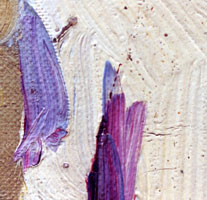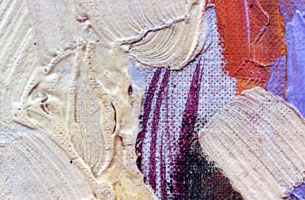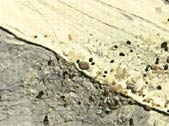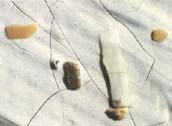 |
MISCELLANEOUS |
 |
Peppered with sand
Lots of sand, grass
blade and dirt is found in our paintings. As we mentioned before,
they were once taken down
from the stretchers, and piled with other canvases. Damages, caused
by folding, bear witness to an ungentle treatment. They were folded
when the paint still had not dried.
Click on the pictures to see them
larger. |
|

Detail of hat showing piece of grass. |

Detail of dress showing grains of sand. |
|

Detail Showing outline-drawing and impression
from another canvas.
Impressions in the
paint surface can bee seen in many places. For a pleasant
comparison, please read this: “The Beach at Trouville, macro detail
of flattened paint, showing canvas impression”, and this: “…is the
quintessential plein-air painting – so much so the surface of the
painting is peppered with grains of real sand…”



Sand grains
and canvas impression on
The Beach at Trouville
(ill. from 'art in the making')
The final texture
effects found in Impressionist paintings are the unusual, singular
ones, unique to particular paintings. Accidental occurrences
like the sand grains on The Beach at Trouville add a pleasing
anecdotal element to our view of the making of the painting.” in
‘Art in the making: Impressionism’ The National Gallery, London,
1990.
” Accidental ” – that´s the question!? Perhaps it was no
accident at all! What we learnt by now from Monet´s paintings is
that they certainly are not created by accident, on the contrary,
the least little detail was carefully calculated . What we also know
is that Monet always enforced that he was painting out of doors, ’en
plein air’. What would be more natural than to prove that the
painting was executed ’on the spot and from nature’ by adding some
grains of sand etc? ”Accidently”…
Another example of such an ’accident’ is the Nymphéas from 1907
in the Göteborg Art Museum. Here a little brown leaf is attached to
the paint surface and it really seems like it is fixed there, on
purpose, with a small daub of paint! It is likely that if such
’souvenirs’ once existed, most of them have disappeared when the
pantings were cleaned by restorers. Just like what happened
to the sandgrains in 'the Beach at Trouville', "Until recent
cleaning, the full extent of the sand was not appreciated, because
much of it had been discreetly retouched during a previous
restoration", Art in the Making Impressionism, p.130.
Press HERE for next page
|
|
|